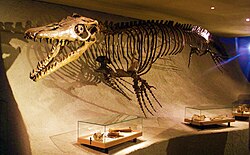Mosasaurus
|
Mosasaurus Temporal range: Late Cretaceous, 70–66 Ma |
|
|---|---|
 |
|
| Mounted skeleton cast of M. hoffmannii, Maastricht Natural History Museum | |
| Scientific classification | |
| Kingdom: | Animalia |
| Phylum: | Chordata |
| Class: | Reptilia |
| Order: | Squamata |
| Superfamily: | †Mosasauroidea |
| Family: | †Mosasauridae |
| Tribe: | †Mosasaurini |
| Genus: |
†Mosasaurus Conybeare, 1822 |
| Type species | |
|
†Mosasaurus hoffmannii Mantell, 1829 |
|
| Species | |
|
†M. missouriensis (Harlan, 1834) |
|
| Synonyms | |
|
Batrachiosaurus Harlan, 1839 |
|
†M. missouriensis (Harlan, 1834)
†M. conodon Cope, 1881
†M. lemonnieri Dollo, 1889
†M. beaugei Arambourg, 1952
Batrachiosaurus Harlan, 1839
Batrachotherium Harlan, 1839
Drepanodon Leidy, 1861 non Nesti, 1826
Lesticodus Leidy, 1861
Baseodon Leidy, 1865
Nectoportheus Cope, 1868
Pterycollosaurus Dollo, 1882
Mosasaurus (/ˌmoʊzəˈsɔːrəs/; "lizard of the Meuse River") is a genus of mosasaurs, extinct carnivorous aquatic lizards. It existed during the Maastrichtian age of the late Cretaceous period, between about 70 and 66 million years ago, in western Europe and North America. The name means "Meuse lizard", as the first specimen was found near the Meuse River (Latin Mosa + Greek sauros lizard).
Mosasaurus was among the last of the mosasaurids, and among the largest. As with most mosasaurids, the legs and feet of Mosasaurus were modified into flippers, and the front flippers were larger than the hind flippers. The largest known species, M. hoffmannii reached lengths up to 17 m (56 ft), slightly longer than its relatives Tylosaurus and Hainosaurus. Mosasaurus was also more robust than related mosasaurids. The skull was more robust than in other mosasaurids, and the lower jaws (mandibles) attached very tightly to the skull. They had deep, barrel-shaped bodies, and with their fairly large eyes, poor binocular vision, and poorly developed olfactory bulbs, experts believe that Mosasaurus lived near the ocean surface, where they preyed on fish, turtles, ammonites, smaller mosasaurs, birds, pterosaurs, and plesiosaurs. Although they were able to dive, they evidently did not venture into deeper waters.
...
Wikipedia
